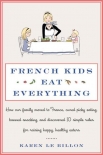French Kids Eat Everything Karen Billon (romance novel chinese novels txt) 📖

- Author: Karen Billon
Book online «French Kids Eat Everything Karen Billon (romance novel chinese novels txt) 📖». Author Karen Billon
Reluctantly, I started sending crackers, and even cookies (having found a source for the lovely little Petit Lu biscuits that had been a favorite back in France). But Sophie came home with a different list: Fruit by the Foot, Oreos, Gummi bears. My refusal to provide these sorts of processed snacks led to fights and resentment; no matter how much I told her she needed to eat healthily, she just wanted to be like the other kids. The only problem was that some of the other kids ate doughnuts for snacks. In frustration, Philippe sat Sophie down in front of the computer and showed her pictures of children with cavities: rotting stumps that impressed Sophie (and us) with their sheer vileness. But she still pestered me for the snacks that other children had. Frustrated, I realized that by banning certain snacks, I was actually inducing cravings for the very same food in Sophie. This seemed to run counter to what I had learned in France.
It didn’t help that some of the snacks I preferred to give her instead were different. When Sophie invited two classmates over to our house for one of her first play dates, I proudly offered up a French-style tarte aux pommes, served in the classic style, with apples carefully arranged in a spiral on the pastry, drizzled with a little lemon and sugar, absent the filling and pastry topping that North American pies usually have. It was greeted with puzzled looks.
“What is this? Apple pizza?” ventured one girl, with that accusatory caution that North American kids so often display around new foods. After some gentle encouragement, she delicately tasted it with the tip of her tongue. The pie, it soon became apparent, didn’t pass muster.
“Can I have some Oreos instead?” Oreos had, in fact, made it into our house. I had finally succumbed to Sophie’s badgering and bought a box. With great anticipation, she had tucked two cookies into her lunch bag earlier that week. They came home almost untouched after she decided that they were “too sweet.” So we had leftover Oreos to share, which the other girls munched happily before leaving the table to play.
I heaved a sigh of relief that my daughter had passed whatever strange social tests six-year-old girls devise for one another and resolved to keep “normal” snacks in the cupboard for just such purposes. And, because I didn’t want Sophie to feel that she was denied foods (and thus develop cravings), I started to be more permissive about snacks. But I also encouraged her to develop preferences for relatively healthier options, like squares of dark chocolate (rather than Oreos) or juice-based “natural” gummy bears. I told her about artificial colors and flavors (so that she’d know why I refused to buy her some snacks). With some grumbling, she consented to my “healthy” choices, and I agreed she could have “sweet treats” twice a week at school: granola bars, natural fruit leather, Petit Lu chocolate cookies.
We even agreed to compromise on fast food. I carefully explained why I wouldn’t take our family to McDonald’s (the fact that my first job as a teenager was a McDonald’s cashier gave me some credibility, which I used for all it was worth). I’m not sure that my explanations of factory farming and “fake food” made much headway with Claire, but they certainly impressed Sophie. Instead, we agreed on an alternative fast food: sushi, which is an easy enough choice in Vancouver, with little mom-and-pop sushi restaurants on nearly every block. And I gave permission for Sophie to accept fast-food restaurant invitations from her friends, following the French principle that “it’s okay to have treats once in a while.” If her friends’ parents took her to McDonald’s while on a play date, I simply smiled and practiced my Miss Manners rule of “if you don’t have anything nice to say…” Usually, I simply (and truthfully) observed: “Sophie must have enjoyed her meal.” To Sophie, I merely said: “I liked McDonald’s too when I was a child. But it’s something that you grow out of.”
However, we still hadn’t solved the school lunch problem. Sophie continued to come home hungry with half-eaten lunches. I pleaded and scolded, and even made special concessions (like slicing all of the crusts off her sandwiches to make them easier to chew). But it didn’t make much of a difference. Sophie had been trained to eat slowly and properly. We had instilled the importance of dégustation in her, and now it was coming back to haunt us.
“Why don’t you just gobble your lunch?” I found myself scolding her one afternoon. I couldn’t quite believe this came out of my mouth after all the time spent teaching her how to eat mindfully.
“All of the other kids are so messy! I chew slowly, with my mouth closed!!” Sophie wailed. It was true—a year of harping on her eating behavior had paid off, and she was a lot tidier than she had been (although still sometimes a messy eater by French standards). This sometimes posed problems at school. The worst was the infamous Cupcake Episode, which Sophie still remembers. One day, she spent her carefully saved pennies on a luscious cupcake at the school’s only bake sale that term. It was crowned with a thick layer of icing and topped with sprinkles. As she tearfully narrated the story to me later that afternoon, she had slowly savored the cupcake, taking little licks of the icing, until the bell rang—lunch was over. Her teacher, seeing the unfinished cupcake, told Sophie she’d “count her down,” but hearing the 5 … 4





Comments (0)